Deskless workers make a significant portion of the overall global workforce. Still, employers have a long way to go in empowering their deskless employees for success. Moreover, deskless workers are often “forgotten” by their employers who tend to be more focused on their deskbound employees.
In this blog, we will cover some interesting facts about deskless workers, the challenges that organizations face with their deskless and frontline employees, as well as how the right technology can keep deskless workforce empowered, engaged, safe, and productive.
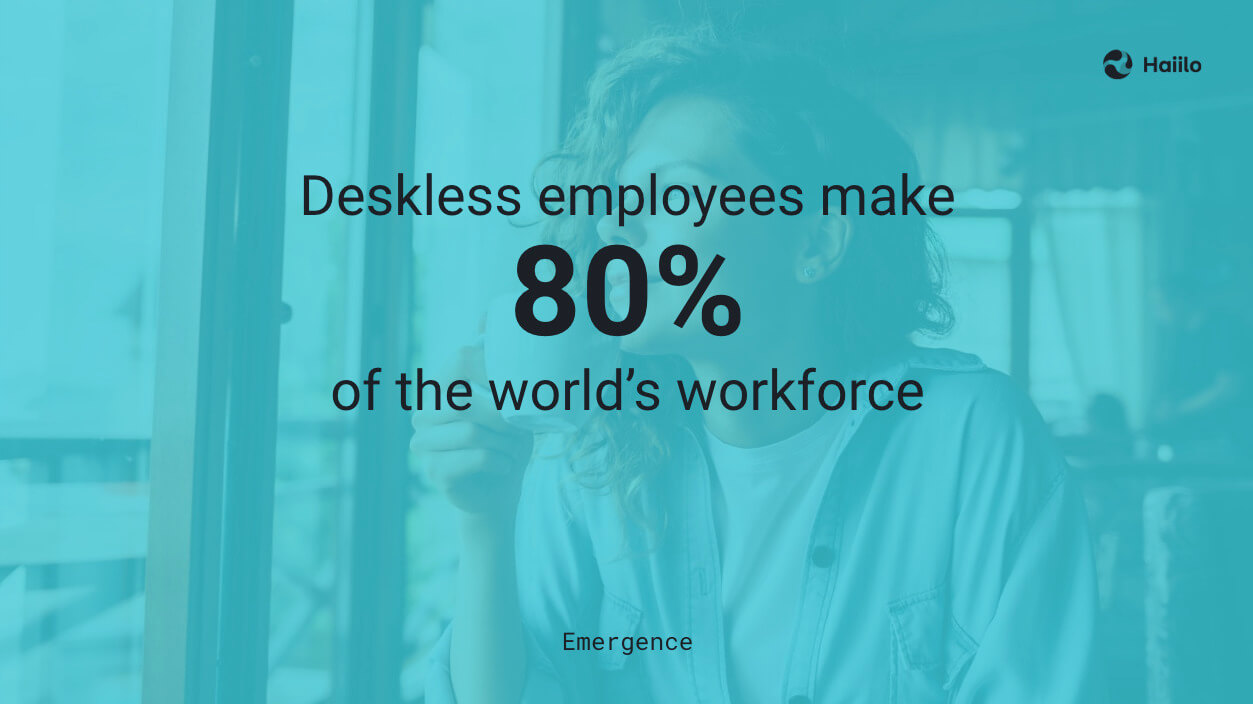
About Deskless Workers
Deskless workers are employees who don’t have designated working space. Today, these workers make an astonishing 80% of the overall global workforce (around 2.7 billion people) and they mostly work in industries such as:
- Healthcare
- Retail
- Manufacturing
- Construction
- Transportation
- Telecommunications
7 Challenges Organizations Face with Deskless Workforce
Deskless workforce is on the front line, making and selling products we enjoy. They are keeping us safe and healthy. Many are now also exposed to higher risks of getting COVID-19 infected compared to employees in their offices and their homes.
But what do organizations do to keep these employees motivated?
It is crucial that employers realize the challenges that come with non-wired employees’ nature of work.
Without company emails or laptops, however, eliminating these challenges can be a tall order for employers.
Most of these workers are in industries like retail and hospitality that suffer from extremely high turnover rates. Therefore, ensuring deskless workers fast and seamless access to their managers, company policies, relevant information, and their company’s brand story is essential.
Let’s take a deeper look into the 7 main challenges organizations face with deskless workers.
They have high turnover rates
According to great research on deskless workforce, organizations with a lot of blue-collar workers struggle to attract and retain their people.
These employees tend to be less loyal and they change their jobs more often compared to office employees. Moreover, many deskless employees see their jobs as temporary, and they don’t see themselves with their current employer long-term.
According to research, many deskless worker industries have some of the highest turnover rates. For example, supermarkets and quick-service restaurant workers have 100% turnover each year.
This is not surprising as many deskless employees are unhappy with their working environment.
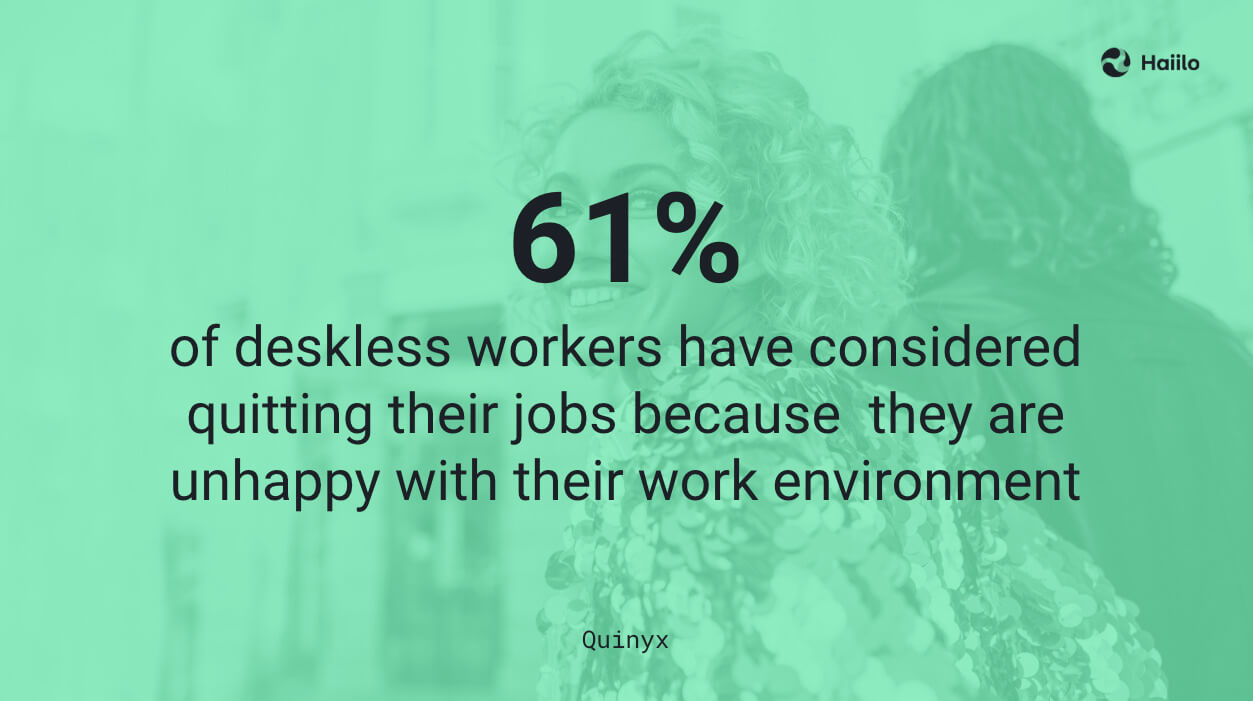
They are hard to reach
A recent study found that over 83% of frontline workers don’t even have a corporate email address, and 45% don’t even have access to the company intranet when at work.
Deskless workers are often at the frontline of your business. They are on the factory or shop floors, out on the field, or on the road. This makes it extremely hard for employers and managers to reach their people in a timely manner. While other workers may be using email, intranets, Slack, Microsoft Teams, and other communication channels, many deskless employees don’t have access to such technology or it’s too complicated for them to use it.
If 74% of all employees feel like they are missing important company information, can you even imagine what that percentage is among deskless workers?
To understand the scope of these challenges, check out this great interview with SAP’s HR Analysts, Mara Hesley where she said:
💡 Related: Why Your Employees Are Missing Out on Important Information.
They don’t have a sense of belongingness
Because of poor workplace communication, deskless employees tend to feel left out, they are not aligned with the company’s strategy, and they often don’t feel like a part of the group.
Furthermore, according to Mara Hesley,
“This lack of an adequate communication channel then contributes to the third-most cited challenge: connectivity to the company culture.”
Since organizations are unable to consistently communicate with deskless workers, this leads to inability to keep these workers connected to the company’s core values.
Because they are often disconnected from the corporate and in-office workers, 80% of remote workers report that they are more likely to feel excluded than in-office employees. Furthermore, 54% of them believe their employer views them as disposable or temporary workers.
💡 Read further about how to keep your remote employees engaged and connected.
They don’t have easy access to the right information
Search for relevant information is a problem among all employees, not just the deskless ones. However, due to their limited access to technology, information search among frontline workers can be a nightmare.
According to a McKinsey report, employees spend 1.8 hours every day searching and gathering information. On average, that’s 9.3 hours per week! Moreover, nearly 20% spend looking for internal information or tracking down colleagues who can help with specific tasks.
Additionally, in the Definitive Guide to America’s Most Broken Processes we can see that 49% of employees say they have trouble locating documents.
They are disconnected and disengaged
In most cases, office workers use more communication and engagement tools than most frontline employees. These tools enable them to always stay connected with their peers and superiors.
On the other hand, many frontline employees feel disconnected and out of the loop from the rest of the company.
A research by Ragan shows that just 56% of deskless workers in the United States feel connected and engaged with their employers. A shocking 84% of deskless workers say they don’t get enough direct communication from top management, and only 10% feel strongly connected to their companies.
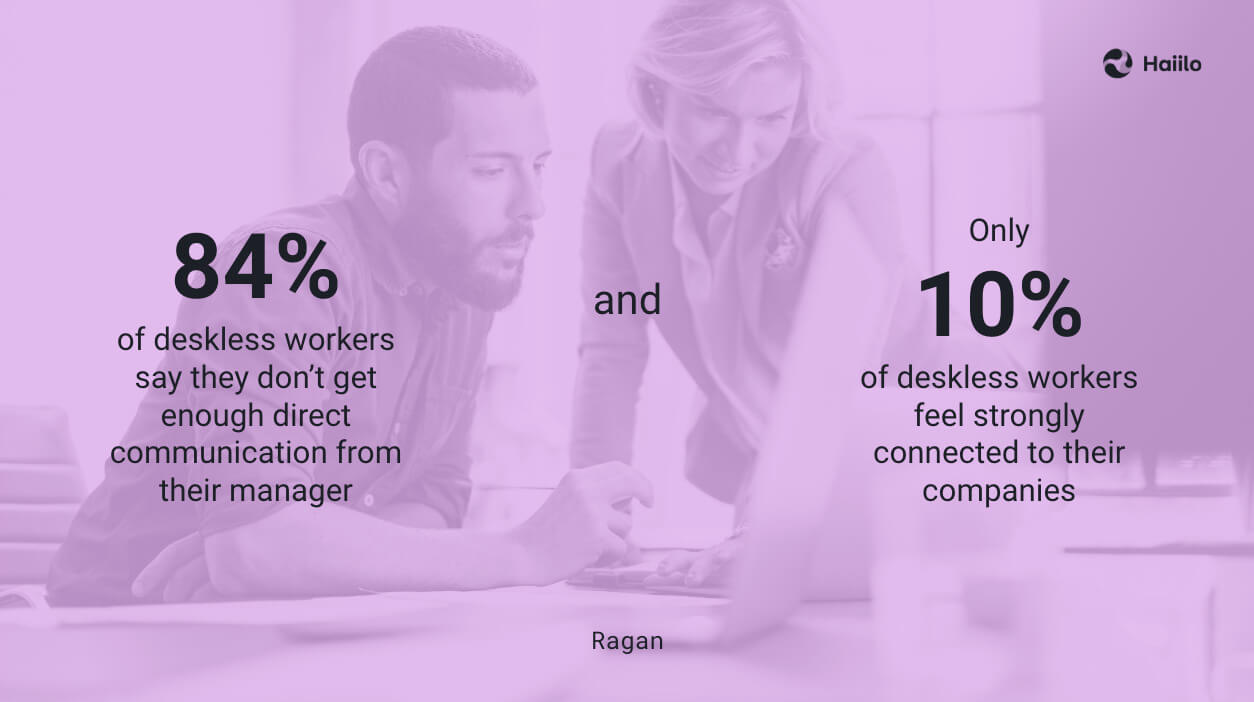
Ultimately, this impacts employees’ productivity and performance. A study by Gallup found that manufacturing organizations with engaged employees outperform those with unengaged employees by 202%.
💡 Read further about how to enable your frontline employee for success.
They are voiceless and don’t feel empowered
Because deskless employees are hard to reach and they are not well connected, they are often voiceless, and feel like their ideas are not heard.
Moreover, according to the State of Deskless Workforce, over 40% of all deskless employees “don’t feel loved” by their employers.
According to another research, only a quarter of employees feel like they can freely express themselves at work. One quarter report that they often choose not to speak up at work, even though they have something they would like to say.
Just over 22% report high levels of expressing their voice to create and implement new ideas.
They are at higher risk of getting injured or ill
Because of their work nature, deskless employees were the ones with many more work-related injuries compared to office employees. Moreover, research shows that the total cost of work injuries in 2018 was $170.8 billion.
Today, with the emergence of COVID-19, this trend is even more obvious. Healthcare and retail employees across the world are at high risk of getting infected. Hence, keeping frontline, blue-collar, and deskless workers safe has become one of the main priorities for employers worldwide and proper workplace communication is the key here.
The Safety Culture Survey administered to hundreds of organizations indicates 90% of respondents believe employees should caution others when they’re operating at-risk. However, only 60% say they actually do provide this critical bottom-up feedback.
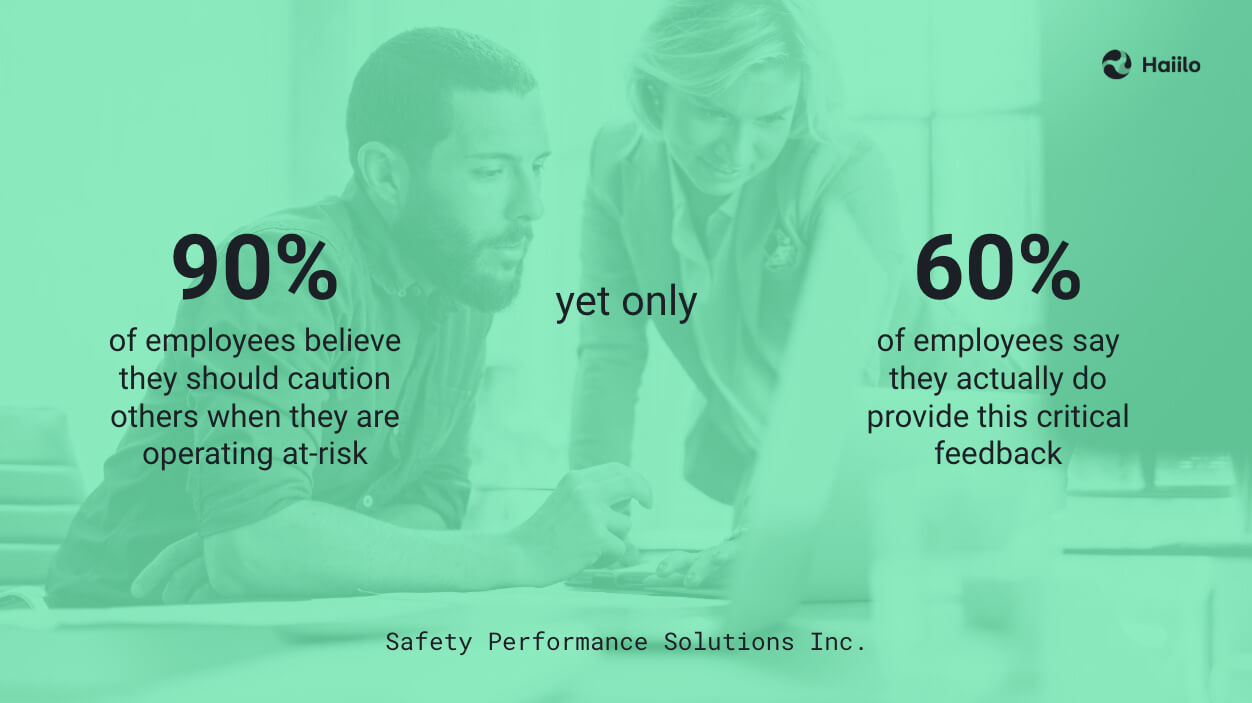
However, due to their nature of work, giving and providing feedback among deskless workers is only possible if there is a fast and easy way to do so.
💡 Also read: 10 Best Practices for Communicating Safety Tips to Your Employees During COVID-19.
Digital Workplaces and Deskless Employees
Today, critical workers in the industries of healthcare, agriculture, construction, retail, manufacturing, telecommunications, transportation, and similar are still not provided with dedicated software that enables them to do their jobs successfully and stay connected with other employees.
However, many organizations today are looking to transform the “future of work” with modern employee apps and innovative communication tools.
While there are many apps, cloud platforms, and SaaS solutions designed for desk-based workers, just 1% of business software spending currently focuses on deskless technologies.
In recent years, the situation has started to change. More and more companies plan to increase their investment in deskless technologies with the goal to empower deskless employees and build a positive workplace culture.
Moreover, The Rise of the Deskless Workforce found that 82% of respondents are planning to increase their budget. The transportation and manufacturing industries are the most willing to invest, with 100% and 91% of companies surveyed respectively expressing their readiness to spend more.
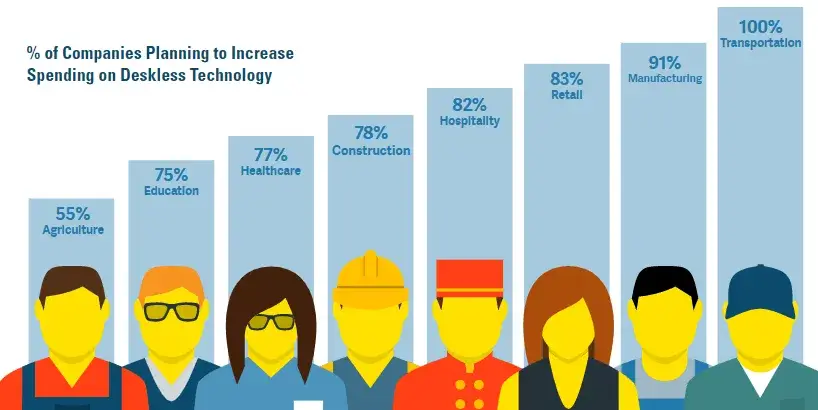
When organizations are asked about why are they investing more in such technology, here is what they say:
- Productivity 33%
- Employee experience 23%
- Cost savings 21%
- Communication 11%
- Customer experience 10%
- Compliance 2%
More Interesting Facts About Deskless Workers
Given that deskless workers require a special approach when it comes to workforce management, many organizations do extensive research to better understand how to keep frontline employees engaged, empowered, and safe at work.
Here are some of the most interesting facts we found from this research:
- 83% of deskless workers get desktop PCs, laptops, or speakers.
- Deskless workers make up about 80% of the global working population.
- Only 6% of respondents rely entirely on digital processes for deskless work, while 44% of organizations rely on paper-based processes half of the time or more. (Source: Skedulo)
- In a 2020 survey, 70% of deskless workers reported they want more tech to do their jobs. (Source: Emcap)
- 83% of the same respondents said that they are provided with desktop PCs and laptops even though their job requires them to be away from the desk. (Source: Emcap)
- 59% of workers feel that the communications they receive are inadequate (Source: Nudge)
- 99% of software venture capital investments target software aimed at desk-based workers. (Source: 2018 study by Emergence Capital)
- 62% of organizations expected their mobile workforce to increase over the next 12-24 months (Source: Skedulo)
- One of four deskless workers states that a lack of purpose-built tech is hampering their everyday work. (Source: Skedulo)
- 83% of deskless workers still rely on paper files for some or all of their processes. (Source: Skedulo)
- 19% of diskless workers feel “somewhat” or “very” disconnected as a result of working away from the central company location. (Source: talentcards)
- Adequate tech is making deskless workers 2X satisfied with their jobs. (Source: Skedulo)
The Role of Technology in Enabling and Empowering Deskless Workers
It is inevitable that new technology is transforming employees’ experience in the workplace. As 92% of millennials have a smartphone, your deskless employees are most likely already comfortable with mobile. Hence, mobile-first type of work is now a reality, especially for deskless workers.
However, a 2020 survey from Emergence shows that 75% of deskless workers spend most of their working day using technology, yet 60% are unsatisfied with the tech they’re given, citing it as slow, inefficient and hard to use.
As employee communication is clearly one of the biggest challenges with deskless employees, it is not surprising that social and communication apps are a big investment priority for modern companies. They have a great power in eliminating the biggest communication barriers in the workplace.
According to previously mentioned research, improved communication and collaboration through social technologies could raise the productivity of interaction workers by 20 to 25%. When organizations use such technology, as McKinsey puts it,:
“Messages become content; a searchable record of knowledge can reduce, by as much as 35%, the time employees spend searching for company information.”
Moreover, investing in an internal communications strategy that leverages mobile technology can play an integral role in reaching employees, making communication more interpersonal, connecting strategy with operations, employees with purpose, and helping companies thrive and grow.
Let’s now take a look into how modern, mobile-first, employee communications apps like Haiilo can enable employers and leaders to better support their people and deskless employees to be more productive and happier at work:
- Create targeted groups and teams to help your employees stay connected no matter where they are located
- Share and amplify company news and updates with frontline employees, just as much as with office-based workers
- Ensure intuitive mobile-first communication for employees who don’t have access to corporate email
- Make all important company documents, updates, and events easily available and accessible to your deskless workforce
- Deliver personalized and relevant information to avoid information overload and eliminate productivity losses
- Send instant push notifications for emergency situations to achieve better and faster readership among deskless workers
- Open up a line of two-way communication so that no one feels voiceless and so that the rest of the company can engage with your deskless workforce
- Automatically import content from trusted and relevant sources of information
- Empower managers to reach out to their teams regardless of their location or job function
- Open up internal communication channels across the organization, so frontline employees can collaborate with anyone
- Integrate various communication channels into a single platform to ensure adoption of the platform and scalability of your communications
- Measure your deskless workforce’s engagement with internal communications campaigns and find actionable insights that help you further hone your communications strategy
- Tie those campaigns with the ultimate business goals and KPIs so that you can better understand the impact and prove the value of workplace communication on the major business objectives. Some of those objectives may include: reducing workplace accidents, improving employees’ productivity, implementing digital transformation projects, and engaging employees in other company-wide initiatives










